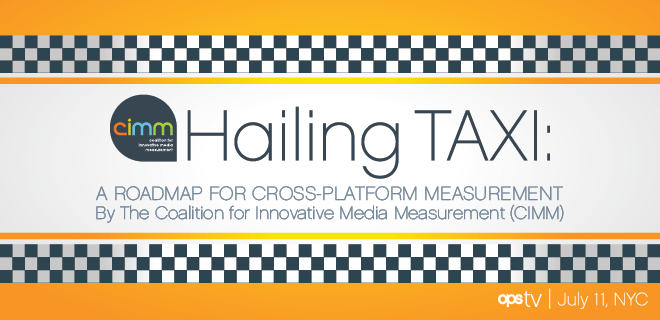
At OPS TV on Wednesday, July 11 in New York, members of the Coalition for Innovative Media Measurement (CIMM) from media companies, media buying agencies and large advertisers will detail the testing for proof of concept for the trackable asset cross-platform identification (TAXI) initiative, as well as the industry implications if the open standard for asset identification is widely adopted.
But you’re probably asking yourself, “What on earth is TAXI?” Here’s a quick primer taken from the executive summary of CIMM and Ernst & Young’s report, which you can download for yourself here.
Stuffed Full of Content
- The volume of content has dramatically increased. The combined increases in the amount of commercial video content and the explosion of distribution channels and delivery platforms has led to a multiplier effect on overall content volume. As a result:
- Content owners are facing incredible difficulty monetizing their assets, and simply figuring out where and when they have been played.
- Advertisers are facing an increasingly inefficient cross-platform supply chain where matching their messages with quality content and audiences is becoming more difficult.
Tracking Slow to Catch Up
- Asset identification and tracking have not kept pace. Key business applications, technologies and supporting operational processes have not scaled commensurate with the content explosion. Fundamentals of trade between entities are still operating on models developed decades ago.
- Content owners are typically able to monetize a very small portion of their overall libraries due to today’s relatively high cost, but low relative return, associated with getting ad-supported long-tail assets in front of consumers.
- The lack of comparability of metrics across channels and platforms has led to confusion with advertisers and their agencies. It is difficult and time-consuming to evaluate ad performance across multiple platforms and channels. Real-time, in-flight campaign adjustments are, in effect, impossible, even though such a capability is highly desired by advertisers.
- Because it is costly and difficult to track content, licensing models have barely evolved despite the plethora of new content monetization opportunities and a commercial interest in doing so.
- The economic benefits of media workflow automation have not been realized because of the difficulty in passing asset-related information, including metadata, between systems that cannot cross-identify assets.
- Enormous, unnecessary cost is incurred across the content and advertising value chain because of duplicate, manual data entry and the constant necessity to map one asset identifier to another.
- The industry is clamoring for a simple, low-cost method for keeping track of content –both entertainment and advertising assets –and numerous schema have emerged, but the industry has yet to coalesce around a common methodology.
The Missing Metric
- The industry wants a way to track assets across platforms. The industry is ready. Executives with whom we spoke clearly articulated the need for trackable asset cross-platform identification(“TAXI”). We met with more than sixty executives from almost twenty entities across the content ecosystem, and were told over and over again that:
- TAXI is desired. The industry appears to have hit a tipping point and is ready for a consistent, open-standard approach to asset identification.
- TAXI is technically feasible.The combination of cloud computing and web services have made this realistic. It can be implemented and operated at a price-point that makes sense.
- TAXI is operationally feasible.Organizations have articulated a plethora of ways in which the TAXI concept would simplify content management and advertising operations, and reduce cycle time and associated costs.
- The industry is ready for TAXI now. The dramatic increase in the volume of content, combined with the pace of innovation around distribution platforms, devices and channels, has created the industry catalyst for the adoption of TAXI.
Essential Elements
- TAXI must address several practical requirements to be successful. There were several key attributes that industry constituents stated must be considered if the TAXI concept is to be adopted as a standard within our industry.
- Simple: TAXI must be easy to implement and operate. The less complex the better. Every entity with whom we spoke reinforced that each additional procedural, operational or technological change that has to be made will increase the barrierto a successful industry-wide TAXI adoption. Keeping it simple was the single most repeated critical success factor.
- Interoperable: Most participants in this study stated that if there was no prevalent asset identification methodology in use today, the TAXI vision would be most simply fulfilled with a single ID solution supported by domain-specific metadata. However, today’s media landscape includes several prevalent asset ID systems, and as such, it is critical that TAXI be designed so that these currently incompatible systems become fully interoperable, at a layer transparent to the people, processes and technologies involved in managing assets, and transmitting and exchanging asset-related information.
- Inextricably bound: Technology standards must be created so that IDs can be permanently linked to their associated assets without degrading quality.
- Extensible: TAXI must be capable of identifying multiple content types, versions and formats, and should be designed flexibly to accommodate emerging and future media asset types.
- Open and global: TAXI must be an open standard. It must be governed by registries accessible to all ecosystem participants and suppliers on a world-wide basis, and adhere to standards that M&E industry companies, including technology suppliers, can utilize across a global footprint.
- Cost effective: TAXI must be value driven –a low cost-barrier to adopt and operate, both in terms of direct costs (one-time implementation costs and ongoing fees paid to the TAXI registry or registries) and indirect costs (operational costs, including labor) to utilize TAXI as the volume of assets and their derivatives continues to climb.
 Pushing Widespread Adoption
Pushing Widespread Adoption
- The TAXI implementation is going to be an enormous industry undertaking.There were significant levels of interest exhibited during this study with an equal appreciation for the full complexity of the task ahead. For TAXI to work, a critical mass of industry participants all need to move forward at the same time in the same way. The industry will thus need a catalyst –a few committed major media companies who implement TAXI and demonstrate its value –to spark widespread concurrent adoption.
- Start by proving TAXI’s value to the C-Suite. The single most important stimulus for TAXI’s success will be demonstrating clear, quantifiable economic benefits that can be achieved in realistic timeframes at reasonable costs. Executives with whom we met stated that a well-publicized and successful “proof of concept” should be undertaken to demonstrate economic upside to CFOs within technical and operational investment parameters deemed feasible to CTOs. We have to prove that this is worth doing, and worth doing now.
- Take steps to attract critical mass before stepping too far. Because certain economic benefits will be achievable only when multiple parties across a given media sector supply-chain adopt TAXI, a phased implementation approach may be the best way to drive tangible business benefits that continuously outweigh implementation costs and “disruption” factors. A stepped approach will improve the likelihood of industry-wide adoption.
- Don’t forget to keep it simple. TAXI must be designed so that there are as few technical and operational barriers as possible. Make TAXI a “no brainer” and the industry will come.
Coming Out Party
TAXI is feasible… now take it to market!
Ernst & Young spoke with more than sixty executives from almost twenty M&E ecosystem companies who each possess a level of business, technical and/or operational depth in asset identification. It was relatively easy to get this group on board. It will be far more difficult to do so with their chiefs… those that will ultimately have to demand TAXI be deployed into the market. For the C-Suite, this must be a burning economic platform –one that has clear revenue growth and cost savings benefits.
Ernst & Young suggests CIMM consider the following steps to make influencing this C-level group easier, and to take TAXI from concept to execution:
- Convene a cross-industry working group to develop technical specifications and agree to an asset identification and metadata schema for one or more pilots, along with an ID-to-asset binding technology. Develop data exchange and transmission standards for each use-case designed to be tested within the pilot(s). The identifier and associated technology and data exchange standards may be re-designed or enhanced pending the outcome of each pilot.
- Design each pilot program to prove TAXI can deliver. Validate anticipated outcomes with participating C-suite executives, and gain commitment that if relevant results are demonstrated, that they will champion the TAXI vision to industry peers.
- Recruit entities across the content production, distribution and advertising value chains to participate in one or more pilots with the goal of proving a combination of revenue opportunities and tangible reductions in overhead costs. Cite tangible, quantifiable benefits that are achievable with TAXI.
- Highly publicize the results through the publication of a “white paper” and/or presentation in a widely-attended press event or conference.
- Initiate a phased approach to implementing the TAXI concept so that ecosystem players’ benefits continually outweigh the amount of disruption incurred. And keep it simple.
 |
Pondering the future of TV and digital video? OPS TV will bring digital advertising leaders and ops professionals together to discuss the intersection of digital video and TV advertising. Register today for OPS TV, which will be held July 11, 2012, in New York. |